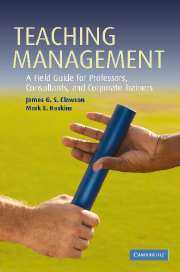Book contents
- Frontmatter
- Contents
- List of figures
- Sources to chapter quotations
- Why this book on teaching management?
- 1 Fundamental elements in teaching
- 2 Levels of learning: one, two, and three
- 3 Adult learning theory: it matters
- 4 Planning a course: trips and tips
- 5 Planning a class: no detail is too small
- 6 Lecturing: the possibilities and the perils
- 7 Managing discussions
- 8 Case method: fostering multidimensional learning
- 9 Role-playing
- 10 Case writing: crafting a vehicle of interest and impact
- 11 Case teaching notes: getting from here to there
- 12 Action learning
- 13 Experiential methods
- 14 Enhancing the conversation: audiovisual tools and techniques
- 15 Executive education: contributing to organizational competitive advantage
- 16 Using technology to teach management
- 17 Counseling students
- 18 Evaluating students: the twin tasks of certification and development
- 19 Teaching evaluations: feedback that can help and hurt
- 20 Research presentations
- 21 Managing a degree program: behind the ‘glory’
- 22 Managing a nondegree client program: an overview
- 23 Dealing with the press
- 24 Managing yourself and your time
- 25 Using teaching portfolios and course portfolios
- 26 Conclusion: is this on the exam?
- Index
22 - Managing a nondegree client program: an overview
Published online by Cambridge University Press: 25 February 2010
- Frontmatter
- Contents
- List of figures
- Sources to chapter quotations
- Why this book on teaching management?
- 1 Fundamental elements in teaching
- 2 Levels of learning: one, two, and three
- 3 Adult learning theory: it matters
- 4 Planning a course: trips and tips
- 5 Planning a class: no detail is too small
- 6 Lecturing: the possibilities and the perils
- 7 Managing discussions
- 8 Case method: fostering multidimensional learning
- 9 Role-playing
- 10 Case writing: crafting a vehicle of interest and impact
- 11 Case teaching notes: getting from here to there
- 12 Action learning
- 13 Experiential methods
- 14 Enhancing the conversation: audiovisual tools and techniques
- 15 Executive education: contributing to organizational competitive advantage
- 16 Using technology to teach management
- 17 Counseling students
- 18 Evaluating students: the twin tasks of certification and development
- 19 Teaching evaluations: feedback that can help and hurt
- 20 Research presentations
- 21 Managing a degree program: behind the ‘glory’
- 22 Managing a nondegree client program: an overview
- 23 Dealing with the press
- 24 Managing yourself and your time
- 25 Using teaching portfolios and course portfolios
- 26 Conclusion: is this on the exam?
- Index
Summary
To improve a company fast, develop people fast.
– Andrall E. Pearson (past president, PepsiCo)Many instructors find themselves with the opportunity to manage an educational experience outside the realm of a traditional degree program, managing educational experiences for major trade associations, single companies, and corporate consortiums, government agencies, and philanthropic organizations. All such settings pose challenges and opportunities that stretch instructors in ways akin to, as well as dissimilar from, those rooted in managing a degree program. In this chapter we will focus on some of the unique aspects of managing a major educational relationship with a Fortune 500 client. It is fair to say that our institution essentially serves as the corporate university for this client, taking on a multifaceted set of responsibilities around the issue of people development.
Issues similar to degree programs
A number of nondegree educational program concerns have counterparts in typical degree programs. Program design issues that address integration, pace, balance, and quality continue to be of critical importance in nondegree educational programs – whether the program lasts two days, or spans several months. Similarly, students in nondegree programs are a part of a classroom affinity group and, in our environment, small-group learning teams. Developing the connections and cohesiveness of those groups is another priority. The principles discussed in the prior chapter regarding those themes, though tailored to the nondegree client, apply here as well.
- Type
- Chapter
- Information
- Teaching ManagementA Field Guide for Professors, Consultants, and Corporate Trainers, pp. 412 - 448Publisher: Cambridge University PressPrint publication year: 2006



